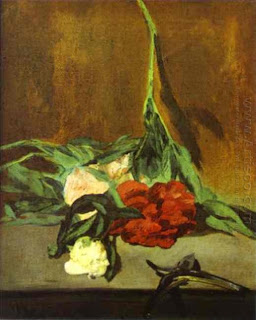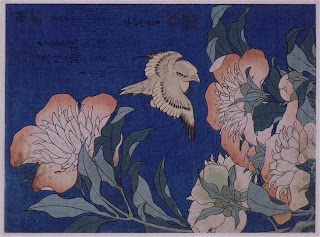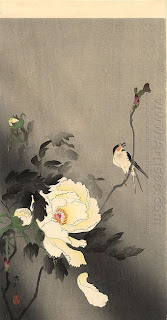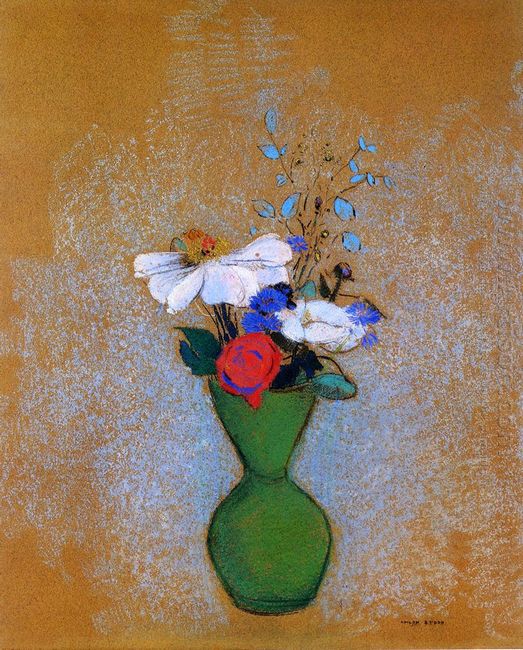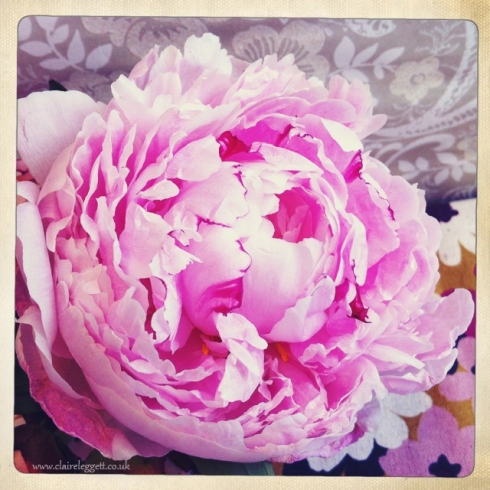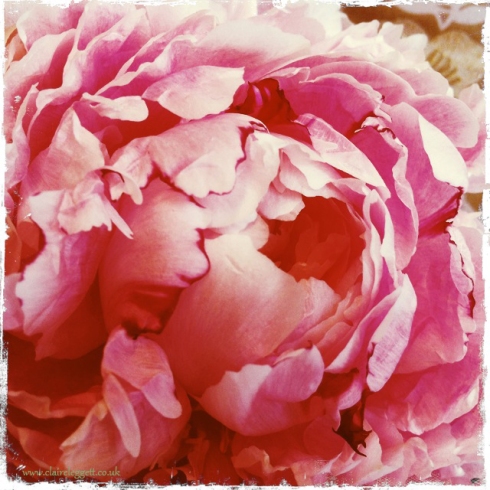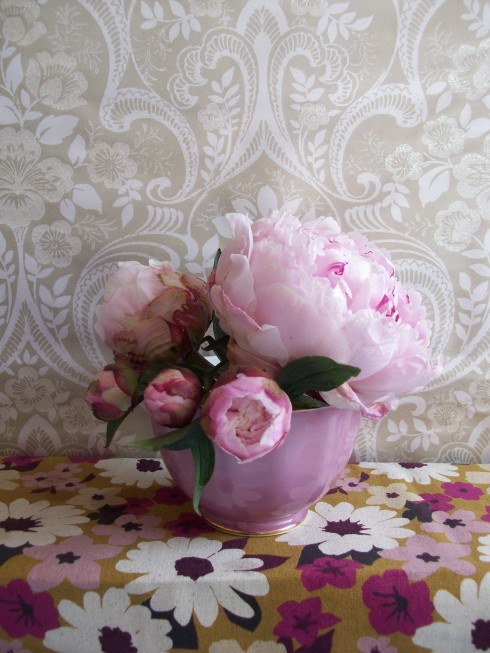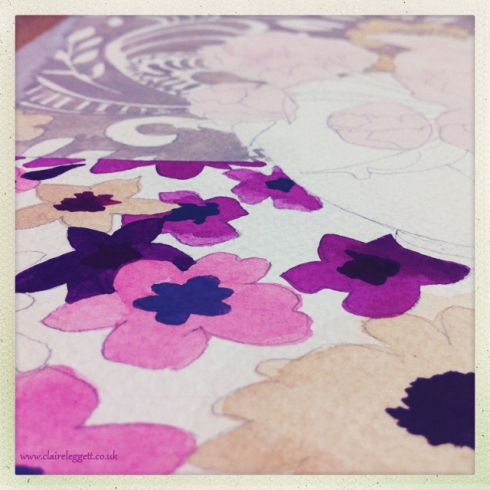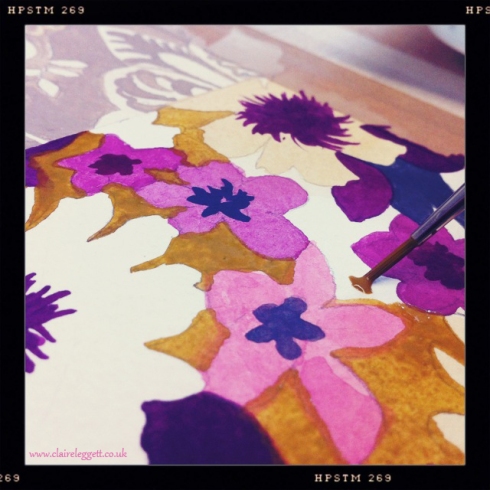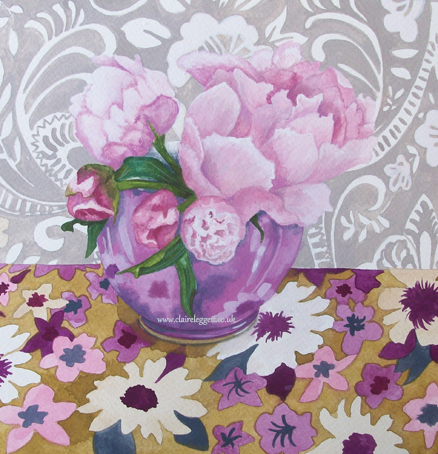Chinese Painting: Peony - Chinese Painting CNAG234738 - Artisoo.com
2013年8月6日星期二
2013年7月31日星期三
Painting Peonies
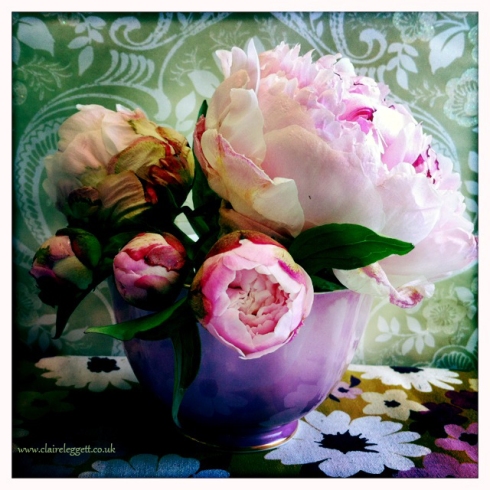 Oh my gosh – I can’t tell you if I’m in love with Peonies more than Hipstamatic or Hipstamatic more than Peonies.
Oh my gosh – I can’t tell you if I’m in love with Peonies more than Hipstamatic or Hipstamatic more than Peonies.
I think this camera app really does, literally, put a rose tinted glow on recording life and having just turned 44, that is something I need around here.
I bought these beauties in Aldi for £2 a bunch.
Now depending on how you view this they are either a bargain or a waste of money because they didn’t all open.
I found that to be a beneficial side effect of their super cheapness though because instead of racing Mother Nature and watching petals unfurl right in front of my paintbrush, they stayed still in the exact same position as they were set up in. Win, win situation – bargain price and co-operative with it .
Peonies are hard to capture though – a bit like trying to paint bubbles, fairy dust or candy floss. They ruffle like a petticoat and undulate in the palest and most subtle colour variations. I kind of wished that my painting style was more emotionally expressive so I could just feel them and capture all that fluff with wild brushstrokes.
But I learnt a long time ago that my style of painting is the only style I have that’s true to me and I couldn’t change the way I paint anymore than I could alter the tone of my voice or my finger prints. I might however alter my shopping habits and ‘go Aldi’ (as the young folk say) more often in search of flowers to paint.
2013年7月29日星期一
Silk Peonies & Hydrangeas
Silk or artificial flower blossoms may look so life-like that you are tempted to touch the petals to check them out. Peony and hydrangea blossoms are crafted from synthetic fibers that are formed in molds by manufacturers for floral arrangements and wreath decorations. The benefit of using these floral reproductions are long-lasting displays of creative flower arrangements.
Peonies
Silk peonies are manufactured and sold as a large singular blossom or a bush with several flowers. The petals are layered to create a large full blossom for a realistic appearance. The singular flower is secured to the top of a heavy plastic coated piece of wire with leaf-bearing twigs. The bush is supported by a series of wires that are secured together at the base of the unit with a heavy plastic coating. Several blossoms, buds and leaves fill a silk peony bush. Cut a peony bush apart and arrange the pieces into a centerpiece. Place individual blooms in a vase or add them into an heirloom wedding bouquet.
Color and Size
The silk peony flower is made in colors that are suited to seasonal decorating projects and wedding bouquets. The large blossoms are dyed to match natural peony colors and artificial shades in earth tones and holiday shades for current home decorating trends. Four to 8-inch wide blossoms are secured onto wired stems that are up to 34 inches tall.
Hydrangea
Silk hydrangea flowers are made in clusters of four petal blossoms to simulate the real florets of the summertime bush. Use the full mass of blooms in large centerpieces, pedestal urns and basket displays. Cut individual florets from the floral spray or bush to use in small floral arrangements, wedding bouquets, corsages and boutonnieres.
Color and Size
Hydrangea florets are 2 to 4 inches across. The florets are secured to plastic stems and clustered onto a 9 to 34-inch tall wired stem. The mass of blossoms of one hydrangea stem will be 10 inches in diameter. A spray of hydrangea blooms often features one large mass of florets, and two smaller mounds of the colorful flowers and leaves. The blossoms come in deep trendy colors, summer pastels, antique white and beige. A silk bush will hold several 5-inch floret clusters.
Peonies
Silk peonies are manufactured and sold as a large singular blossom or a bush with several flowers. The petals are layered to create a large full blossom for a realistic appearance. The singular flower is secured to the top of a heavy plastic coated piece of wire with leaf-bearing twigs. The bush is supported by a series of wires that are secured together at the base of the unit with a heavy plastic coating. Several blossoms, buds and leaves fill a silk peony bush. Cut a peony bush apart and arrange the pieces into a centerpiece. Place individual blooms in a vase or add them into an heirloom wedding bouquet.
Color and Size
The silk peony flower is made in colors that are suited to seasonal decorating projects and wedding bouquets. The large blossoms are dyed to match natural peony colors and artificial shades in earth tones and holiday shades for current home decorating trends. Four to 8-inch wide blossoms are secured onto wired stems that are up to 34 inches tall.
Hydrangea
Silk hydrangea flowers are made in clusters of four petal blossoms to simulate the real florets of the summertime bush. Use the full mass of blooms in large centerpieces, pedestal urns and basket displays. Cut individual florets from the floral spray or bush to use in small floral arrangements, wedding bouquets, corsages and boutonnieres.
Color and Size
Hydrangea florets are 2 to 4 inches across. The florets are secured to plastic stems and clustered onto a 9 to 34-inch tall wired stem. The mass of blossoms of one hydrangea stem will be 10 inches in diameter. A spray of hydrangea blooms often features one large mass of florets, and two smaller mounds of the colorful flowers and leaves. The blossoms come in deep trendy colors, summer pastels, antique white and beige. A silk bush will hold several 5-inch floret clusters.
2013年7月28日星期日
Flowers in Chinese Culture
In Chinese culture flowers are seen as a means of soundless communication. Different flowers have different meanings based on their delicacy and color. Being able to give and receive the appropriate flowers and understand their meaning is a sign that a person has knowledge of, and respects, Chinese traditions and culture.
Popular Flowers
In Chinese culture many flowers have positive symbolic meanings and are often given as gifts at special occasions.
Orchids symbolize love and fertility and are a common gift for newlyweds and expectant mothers.
Peonies are often found in traditional Chinese paintings. They are a symbol of wealth and honor.
The plum blossom, which appears in the depths of winter, represents solidity and firmness. The blossom also symbolizes five blessings (fu), making the flower a symbol of luck. Lilies represent unity of spirit and are popular gifts between close friends and at weddings. Narcissus are believed to have supernatural powers and so are used the ward off evil spirits and for exorcism. Some believe they can bring the dead back to life.
Medicinal Flowers
In traditional Chinese medicine, many flowers are thought to have healing powers. For example, the plum flower is thought to cure coughs, heat stroke and diarrhoea, the Chinese rose can remove bruises and the chrysanthemum is believed to cure a cold.
Religious Flowers
The lotus, and to a lesser extent, the chrysanthemum are associated with religion in China. The lotus, known as “lianhua” and “shuizhi” in Chinese, stands for the four virtues in the Buddhist religion. Consequently, Buddhist literature is often referred to as “lotus literature” and Buddhist houses “lotus dwellings.” This flower also symbolizes purity and holiness as, despite growing in muddy pond water, it produces a beautiful flower. This is seen as a sign that people can be successful regardless of their background. It is also revered as most parts of it can be used, the roots can be eaten and the seeds can be used for medicine. Chrysanthemums are often given as an offering at altars as they represent a good and strong life. They are also given as a gift to the elderly for the same reason.
Negative Flowers
Although most flowers are positive symbols, some should be avoided. Poplar trees can be easily broken and blown away, and so they represent an unfaithful lover. Duckweed, as a floating flower with no roots, contradicts the Chinese cultural values of unity and harmony. Flowers with thorns or thistles should be avoided as these symbolize unhappiness and pain.
Colors of Flowers
The color of flowers is very important. Different colors have different meanings. In general, red, yellow and lilac are all positive colors. Red symbolizes luck and prosperity, yellow (particularly a yellow rose) is the color of victory, and lilac represents modesty, which is a highly valued Chinese virtue. White flowers should be avoided as they are a sign of death.
Popular Flowers
In Chinese culture many flowers have positive symbolic meanings and are often given as gifts at special occasions.
Orchids symbolize love and fertility and are a common gift for newlyweds and expectant mothers.
Peonies are often found in traditional Chinese paintings. They are a symbol of wealth and honor.
The plum blossom, which appears in the depths of winter, represents solidity and firmness. The blossom also symbolizes five blessings (fu), making the flower a symbol of luck. Lilies represent unity of spirit and are popular gifts between close friends and at weddings. Narcissus are believed to have supernatural powers and so are used the ward off evil spirits and for exorcism. Some believe they can bring the dead back to life.
Medicinal Flowers
In traditional Chinese medicine, many flowers are thought to have healing powers. For example, the plum flower is thought to cure coughs, heat stroke and diarrhoea, the Chinese rose can remove bruises and the chrysanthemum is believed to cure a cold.
Religious Flowers
The lotus, and to a lesser extent, the chrysanthemum are associated with religion in China. The lotus, known as “lianhua” and “shuizhi” in Chinese, stands for the four virtues in the Buddhist religion. Consequently, Buddhist literature is often referred to as “lotus literature” and Buddhist houses “lotus dwellings.” This flower also symbolizes purity and holiness as, despite growing in muddy pond water, it produces a beautiful flower. This is seen as a sign that people can be successful regardless of their background. It is also revered as most parts of it can be used, the roots can be eaten and the seeds can be used for medicine. Chrysanthemums are often given as an offering at altars as they represent a good and strong life. They are also given as a gift to the elderly for the same reason.
Negative Flowers
Although most flowers are positive symbols, some should be avoided. Poplar trees can be easily broken and blown away, and so they represent an unfaithful lover. Duckweed, as a floating flower with no roots, contradicts the Chinese cultural values of unity and harmony. Flowers with thorns or thistles should be avoided as these symbolize unhappiness and pain.
Colors of Flowers
The color of flowers is very important. Different colors have different meanings. In general, red, yellow and lilac are all positive colors. Red symbolizes luck and prosperity, yellow (particularly a yellow rose) is the color of victory, and lilac represents modesty, which is a highly valued Chinese virtue. White flowers should be avoided as they are a sign of death.
2013年7月27日星期六
Flowers of the Orient
Flowers bloom furiously throughout the orient. China alone has more than 31,000 species of native plants and many, such as regal lilies, rhododendrons and impatiens, are familiar to gardeners who now grow them all over the world. Some of the most highly prized flowers of the orient cross borders and cultures and have played a role in daily life for centuries.
The Peony
China does not have a national flower, the peony may hold the unofficial title. The perennial plants and shrubs bloom in the spring and early summer, and the flowers are large, colorful and fragrant. The city of Luoyang holds an annual 10-day festival to celebrate the flowers that range in color from creamy white and soft pink to lavender and scarlet. Ancient Chinese healers used the seeds, root and bark to treat nervous tension. Artists showcased the flowers in prints, tapestries and imperial designs. Peonies arrived in Japan sometime in the eighth century, and have been cultivated in that country with equal enthusiasm.
The Lotus Flower
Cultures throughout the orient value the lotus for its beauty and symbolism. Like the water lily, the lotus roots in the the mud of a pond but its large, colorful flowers float on the surface. The flower represents purity, spirituality and achieved enlightenment in Buddhist and Hindu traditions. Traditional medicine uses the leaves and seeds to treat common ailments such as fever and nausea. The lotus flower has the ability to regulate its own temperature and can retain heat despite its surrounding environment. Scientists believe the flower's ability to generate its own heat is tied to the need to attract insects for pollination.
Hibiscus
Known as the rose of Sharon, the hibiscus is the national flower of Korea and has a long history of cultivation in India and China. Although the Korean name for the flower, mugunghwa, means immortality, the large pink, lavender and bright red blossoms fade and die within a day. However, the plant does produce a large number of buds and blooms throughout the summer. People have traditionally eaten the leaves cooked or raw as an ingredient in salads and used the plant as a treatment for rashes and stomach ailments.
Cherry Blossoms
In March, Japanese news agencies begin broadcasting regular updates on the annual flowering of the country's cherry trees. Although cherry trees are native to much of Asia, they are prized most highly in Japan, where people hold parties and picnics to celebrate the small, sweet smelling flowers. Cherry blossoms bloom and fade within a two- to three-week period and the flowers have long been seen as a reminder of the transience of life.The flowers are often linked with Samurai culture because of the glorious but often brief lives of the famous warriors.
The Rumdul
The rumdul, a yellowish-white flower that resembles a bell surrounded by three large petals, is the national flower of Cambodia.The attractive plant grows up to 36 feet, and is valued for the flowers' fragrance which drifts for considerable distances. The flower has a history as an ingredient in lip gloss and as a object of beauty associated with femininity.
The Peony
China does not have a national flower, the peony may hold the unofficial title. The perennial plants and shrubs bloom in the spring and early summer, and the flowers are large, colorful and fragrant. The city of Luoyang holds an annual 10-day festival to celebrate the flowers that range in color from creamy white and soft pink to lavender and scarlet. Ancient Chinese healers used the seeds, root and bark to treat nervous tension. Artists showcased the flowers in prints, tapestries and imperial designs. Peonies arrived in Japan sometime in the eighth century, and have been cultivated in that country with equal enthusiasm.
The Lotus Flower
Cultures throughout the orient value the lotus for its beauty and symbolism. Like the water lily, the lotus roots in the the mud of a pond but its large, colorful flowers float on the surface. The flower represents purity, spirituality and achieved enlightenment in Buddhist and Hindu traditions. Traditional medicine uses the leaves and seeds to treat common ailments such as fever and nausea. The lotus flower has the ability to regulate its own temperature and can retain heat despite its surrounding environment. Scientists believe the flower's ability to generate its own heat is tied to the need to attract insects for pollination.
Hibiscus
Known as the rose of Sharon, the hibiscus is the national flower of Korea and has a long history of cultivation in India and China. Although the Korean name for the flower, mugunghwa, means immortality, the large pink, lavender and bright red blossoms fade and die within a day. However, the plant does produce a large number of buds and blooms throughout the summer. People have traditionally eaten the leaves cooked or raw as an ingredient in salads and used the plant as a treatment for rashes and stomach ailments.
Cherry Blossoms
In March, Japanese news agencies begin broadcasting regular updates on the annual flowering of the country's cherry trees. Although cherry trees are native to much of Asia, they are prized most highly in Japan, where people hold parties and picnics to celebrate the small, sweet smelling flowers. Cherry blossoms bloom and fade within a two- to three-week period and the flowers have long been seen as a reminder of the transience of life.The flowers are often linked with Samurai culture because of the glorious but often brief lives of the famous warriors.
The Rumdul
The rumdul, a yellowish-white flower that resembles a bell surrounded by three large petals, is the national flower of Cambodia.The attractive plant grows up to 36 feet, and is valued for the flowers' fragrance which drifts for considerable distances. The flower has a history as an ingredient in lip gloss and as a object of beauty associated with femininity.
2013年7月26日星期五
Guide to Painting Flowers
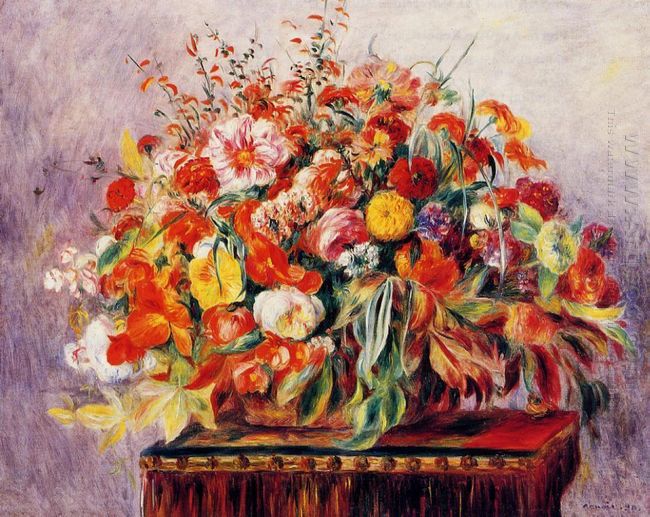 |
| Basket Of Flowers |
Subject
Flowers can be easily painted from imagination, from a photograph or from a live subject. Most people will find that working from a live subject will inform the painting in positive ways while adding a level of depth and complexity. If you wish to paint from imagination, it is helpful to observe and sketch live subjects before beginning your painting. Flowers are so present in our daily lives that they can become iconic when painted from imagination.
Medium
Watercolor, acrylic and oil paints may all yield significantly different results. Watercolors are transparent, luminous and whimsical, perfect for a painting of a flower. They are also difficult to control, so the painter should be relaxed about the results.
Acrylics are solid, bright and bold. They are quick drying and difficult to blend, but easy to paint over again and again. Painting a flower from acrylic will likely result in a vibrant (and maybe even edgy) image. Acrylics are permanent and non-fading.
Oil paints are similar to acrylic paints, but they are much more slow drying. The results may be slightly softer and less hard-edged, but otherwise similar to acrylic. Blending is easier for oil paints. Oil paints may yellow slightly with time, depending on the quality of the paint. This happens over a course of many, many years.
Painting
Break the flower down into its basic parts to begin. For example, if you are painting a sunflower, begin with the large circular center. Make the radiating petals, then the stem and leaves. Take the image one piece at a time.
You may choose to leave the background non-specific and relatively flat (painting only a few colors blended together, making the flower the obvious center of attention) or you may wish to paint a realistic background, such as a room or a garden.
If you are painting with acrylic or oil, you will want to begin by painting in thin washes and build color and paint in layers. If you are painting with watercolor, you will want to start off with lighter colors and build in layers (remember: watercolor cannot be erased and cannot be corrected very well once it is on the paper).
Finishing
You may wish to set your painting aside for a while and return to it with fresh eyes at a later time. Especially if you are working with oils, this will be important. Oil paints dry so slowly that once the canvas is saturated and wet, changes will be difficult to make until the paint has been given several hours or days to dry. You may wish to have someone else look at your painting before putting on the final touches. If you are painting this specifically to decorate a room, you may wish to put the painting on the wall to see if it looks right where you expect to hang it.
Once the painting is done, you may wish to have it professionally framed. Alternatively, if the painting is on a canvas, you can hang it without a frame. Paint the sides of the canvas to give it a finished look.
2013年7月25日星期四
How to Paint Flower Petals
Children love to paint flowers because of their beauty and simplicity of design. For adults, painting flowers on a more sophisticated level really isn't much more difficult, although it does take keen observation of the flower and a little more thought. This may be done in any medium, although most painters use oil, acrylic or watercolor.
Draw the outline of the flower blossom on your canvas or paper.
Note that using watercolor is different from using oil paint or acrylic because watercolor is a translucent medium. If you will be using watercolor, draw lightly so the lines will not show through the painting.
Mix the base color for the flower petal on your palette. Some flowers are vibrant; others have soft coloring. It is important to match the hue of the flower. If you are working from a photograph, try holding the picture up to the palette to ensure the best match. Flick your eyes back and forth between the petal and the color on the palette.
Dip your paintbrush in the paint color on the palette, and apply it to canvas or paper. Start from the inside of the flower petal and paint outward to the edges so that the brushstrokes move from the inside out, along the contours of the petal. Repeat this step for each flower petal. For overlapping petals, paint the bottom petals first and move upward, covering the bottom petals with the top petals as you progress.
Note that if you are using watercolor, you cannot effectively cover one color with another. Paint cautiously. Do not entirely cover the petals with the base color unless the petals are that color only. Additionally, if there are highlights on the petals, paint light layers and build slowly, leaving the petals light in the places where the highlights are located.
Examine the subject, and note the color variations on the petal. Mix the appropriate colors on your palette. For shadows on the petal, it’s best not to use black. Try using shades of blue or brown—refer to the subject for the best choice. Add the blue or brown to your base color with discretion. The shadows on your flower petal will likely not be deep.
Use a detail brush to paint the color variations on the petal where appropriate. Some flower petals shift color from the inside of the petal out, moving from one color to another in a gradient, some are spotted, and some have stripes. Paint details on the flowers as necessary.
Draw the outline of the flower blossom on your canvas or paper.
Note that using watercolor is different from using oil paint or acrylic because watercolor is a translucent medium. If you will be using watercolor, draw lightly so the lines will not show through the painting.
Mix the base color for the flower petal on your palette. Some flowers are vibrant; others have soft coloring. It is important to match the hue of the flower. If you are working from a photograph, try holding the picture up to the palette to ensure the best match. Flick your eyes back and forth between the petal and the color on the palette.
Dip your paintbrush in the paint color on the palette, and apply it to canvas or paper. Start from the inside of the flower petal and paint outward to the edges so that the brushstrokes move from the inside out, along the contours of the petal. Repeat this step for each flower petal. For overlapping petals, paint the bottom petals first and move upward, covering the bottom petals with the top petals as you progress.
Note that if you are using watercolor, you cannot effectively cover one color with another. Paint cautiously. Do not entirely cover the petals with the base color unless the petals are that color only. Additionally, if there are highlights on the petals, paint light layers and build slowly, leaving the petals light in the places where the highlights are located.
Examine the subject, and note the color variations on the petal. Mix the appropriate colors on your palette. For shadows on the petal, it’s best not to use black. Try using shades of blue or brown—refer to the subject for the best choice. Add the blue or brown to your base color with discretion. The shadows on your flower petal will likely not be deep.
Use a detail brush to paint the color variations on the petal where appropriate. Some flower petals shift color from the inside of the petal out, moving from one color to another in a gradient, some are spotted, and some have stripes. Paint details on the flowers as necessary.
2013年7月24日星期三
How to Draw Flowers
Drawing flowers can be a beautiful and addictive way to start drawing. Here are a couple of easy steps to follow.
Start by looking at some pictures of flowers. Pick one of your favorites and have that in mind before you begin to draw.
Start by drawing the stem which should be bent by the weight of the flower and directed towards the sun. Draw two leaves on opposite sides.
Depending on the type of flower that you chose, start from the upper stem, commencing thin and widening out as you get to the end. If it's a sunflower or peony, draw the center circle first and then draw the petals. If you are drawing a rosebud, peony or another flower, remember the many layers that the flower has. Draw the details of the flower.
Color in your flower with different shades of one base color, and remember to color darkest the part that is furthest away from the sun.
Start by looking at some pictures of flowers. Pick one of your favorites and have that in mind before you begin to draw.
Start by drawing the stem which should be bent by the weight of the flower and directed towards the sun. Draw two leaves on opposite sides.
Depending on the type of flower that you chose, start from the upper stem, commencing thin and widening out as you get to the end. If it's a sunflower or peony, draw the center circle first and then draw the petals. If you are drawing a rosebud, peony or another flower, remember the many layers that the flower has. Draw the details of the flower.
Color in your flower with different shades of one base color, and remember to color darkest the part that is furthest away from the sun.
2013年7月23日星期二
List of Chinese Flowers
Flowers in China are appreciated for more than just their outer beauty. They are used for many purposes such as medicine and food, and often have a deep cultural meaning. Many flowers blooming in western gardens have been cultivated in China for hundreds of years. If you are planting a garden with a Chinese theme, several flowers will give your garden a touch of Chinese tradition.
Peony Blossom
Paeonia (peony or paeony) is a genus of flowering plants, the only genus in the family Paeoniaceae. They are native to Asia, Southern Europe and Western North America. Boundaries between species are not clear and estimates of the number of species range from 25 [1] to 40.[2]
Most are herbaceous perennial plants 0.5–1.5 metres (1.6–4.9 ft) tall, but some resemble trees 1.5–3 metres (4.9–9.8 ft) tall. They have compound, deeply lobed leaves and large, often fragrant, flowers, ranging from red to white or yellow, in late spring and early summer.
Plum Blossom
One of the most treasured flowers of China, the plum blossom is often depicted in traditional Chinese paintings. The plum blossom, or “prunus mume,” is native to China and has been cultivated there for at least 1500 years. The flower blooms annually, and its petals range from white to red in color or often a mix of both, producing pink blossoms. The plum blossom grows on a tree that can grow up to 20 feet high.
Lotus
The lotus flower, or Chinese water lily, is a water plant native to China. The roots grow in the mud at the bottom, while the long stem allows the flower to float on the water’s surface. The lotus’ petals are usually white or pink and have pointed edges. Lotus flowers produce large green seed pods, which are often dried and used for decorative purposes. The seeds in the pod are edible. The porous root of the lotus is commonly used in Chinese cuisine and medicine. In Chinese culture, the lotus represents virtue and purity.
Chrysanthemum
The chrysanthemum was first cultivated in ancient China and is an important flower in Chinese culture. It represents nobility and has been celebrated in poems. Every autumn, the chrysanthemum is represented in art and celebratory items during the Double Ninth Festival. Chrysanthemums are also used in Chinese tea, cuisine and medicine. The flower comes in a wide variety of shapes, colors and sizes, but the Chinese variety is usually pale to canary yellow with many long, thin petals. The chrysanthemum is featured on one side of the one yuan coin.
Cape Jasmine
Cape jasmine, or “zhi zi” in Mandarin, is a very fragrant type of gardenia native to China. Zhi zi is a white flower with similar petals and shape to the common rose. Like many flowers, cape jasmine is used in Chinese medicine. Its medicinal properties can help relieve a variety of intestinal and liver conditions. Because of its pleasant, vanilla-like fragrance, the cape jasmine is often used to flavor desserts and beverages.
Peony Blossom
Paeonia (peony or paeony) is a genus of flowering plants, the only genus in the family Paeoniaceae. They are native to Asia, Southern Europe and Western North America. Boundaries between species are not clear and estimates of the number of species range from 25 [1] to 40.[2]
Most are herbaceous perennial plants 0.5–1.5 metres (1.6–4.9 ft) tall, but some resemble trees 1.5–3 metres (4.9–9.8 ft) tall. They have compound, deeply lobed leaves and large, often fragrant, flowers, ranging from red to white or yellow, in late spring and early summer.
 |
| Peony Blossom Painting |
Plum Blossom
One of the most treasured flowers of China, the plum blossom is often depicted in traditional Chinese paintings. The plum blossom, or “prunus mume,” is native to China and has been cultivated there for at least 1500 years. The flower blooms annually, and its petals range from white to red in color or often a mix of both, producing pink blossoms. The plum blossom grows on a tree that can grow up to 20 feet high.
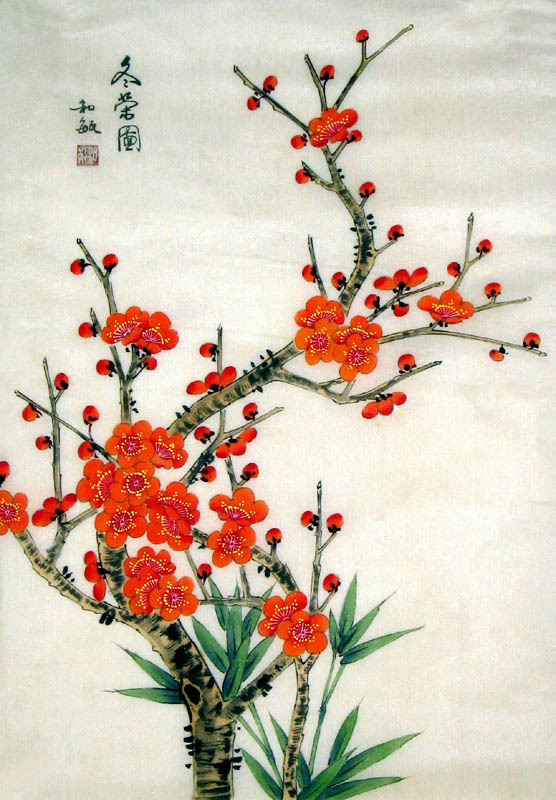 |
| Chinese Plum Blossom Painting |
Lotus
The lotus flower, or Chinese water lily, is a water plant native to China. The roots grow in the mud at the bottom, while the long stem allows the flower to float on the water’s surface. The lotus’ petals are usually white or pink and have pointed edges. Lotus flowers produce large green seed pods, which are often dried and used for decorative purposes. The seeds in the pod are edible. The porous root of the lotus is commonly used in Chinese cuisine and medicine. In Chinese culture, the lotus represents virtue and purity.
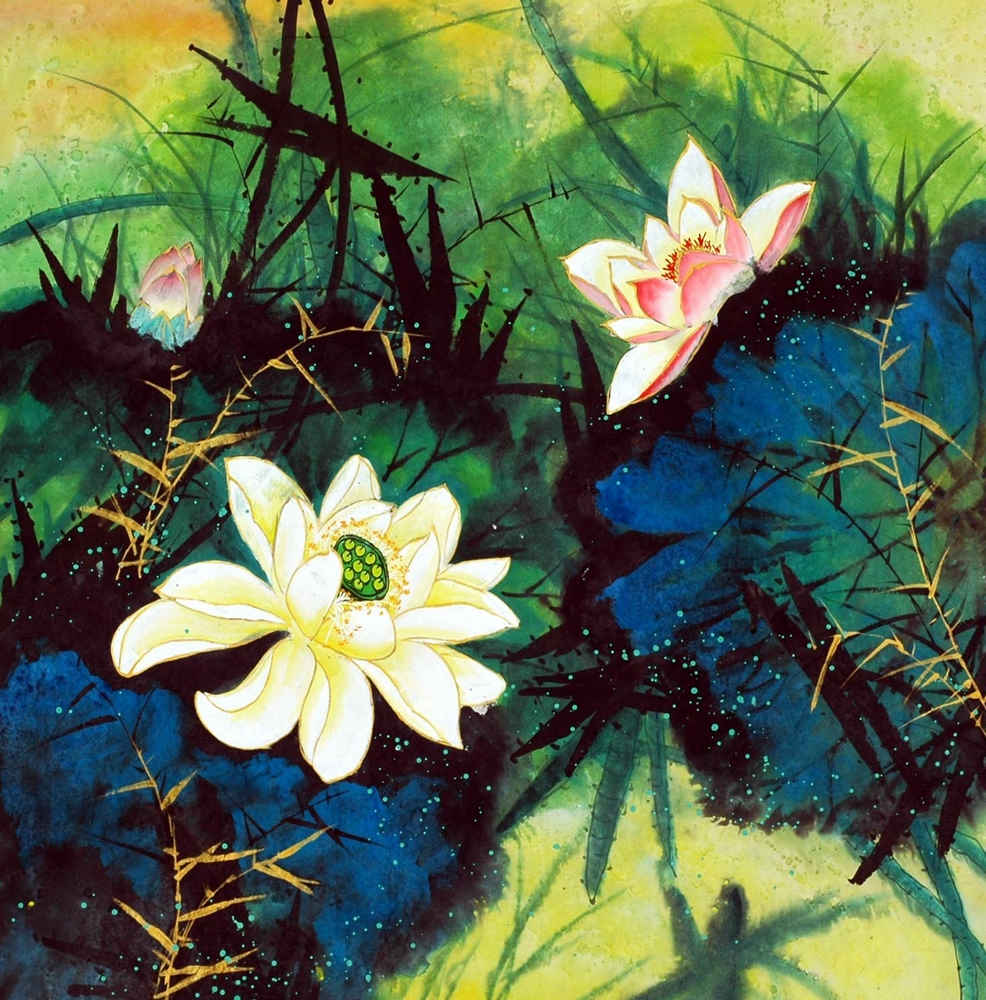 |
| Chinese Lotus Paintings |
Chrysanthemum
The chrysanthemum was first cultivated in ancient China and is an important flower in Chinese culture. It represents nobility and has been celebrated in poems. Every autumn, the chrysanthemum is represented in art and celebratory items during the Double Ninth Festival. Chrysanthemums are also used in Chinese tea, cuisine and medicine. The flower comes in a wide variety of shapes, colors and sizes, but the Chinese variety is usually pale to canary yellow with many long, thin petals. The chrysanthemum is featured on one side of the one yuan coin.
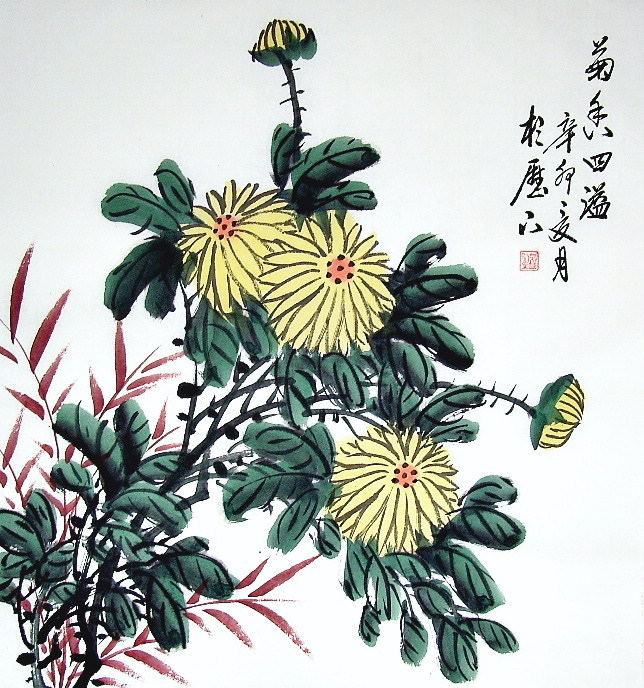 |
| Chinese Chrysanthemum Painting |
Cape Jasmine
Cape jasmine, or “zhi zi” in Mandarin, is a very fragrant type of gardenia native to China. Zhi zi is a white flower with similar petals and shape to the common rose. Like many flowers, cape jasmine is used in Chinese medicine. Its medicinal properties can help relieve a variety of intestinal and liver conditions. Because of its pleasant, vanilla-like fragrance, the cape jasmine is often used to flavor desserts and beverages.
2013年7月14日星期日
The Best Peonies for Cutting
Peony blossoms are among the largest, most extravagant of garden flowers. The huge blooms provide displays that were immortalized in still life paintings by the Dutch masters. Enjoy cutting peonies to fill your pitchers and vases to overflowing, or to provide a fragrant bridal bouquet during the short blooming season of late May through early June. Planting early, mid- and late-season bloomers extends the season.
Single Peonies
All peonies have at least five outer guard petals and a center of stamens. Single peony flowers have centers of pollen-bearing stamens. Single peonies are very effective as cut flowers. Cardinal's Robe is brilliant red with 26-inch stems. Coral N Gold is fragrant with coral guard petals and a golden center. It blooms on strong 36-inch stems. Green Lotus, on 29-inch stems, has white-fringed petals and a sunny yellow center. It is a very attractive and unusual-looking cut flower.
Semi-Double Peonies
Semi-double peony flowers have pollen-bearing stamens among the petals and two or more rows of petals. The large flowers can be up to 10 inches across. Semi-double peonies stand up in the garden without support, making them good candidates for cutting. Buckeye Belle, a rich wine-red, has sturdy 30-inch stems and holds its head without support. Coral Charm, on strong 36-inch stems, is a soft, coral-type peach color. Firebelle opens bright red guard petals to display a sunny center on strong 30-inch stems. Illini Belle, on very strong stems, is burgundy-red with a red and yellow center.
Double Peonies
The centers of double peony flowers consist of broad petals that are transformed stamens. These are the very full, fluffy peonies and usually need staking in the garden. As cut flowers, they may nod their heads. Alexander Fleming is a very fragrant bright pink. Alice Harding is a deep, brilliant yellow. Fragrant Festiva Maxima is white with red flecks. Rachel is deep, bright pink, and Red Grace is cardinal red. Francis Willard opens pink, then fades slowly lighter to white. This peony is fragrant with strong stems.
Japanese Flowered Peonies
Japanese, or Imperial peonies display a cluster of stamenodes in the center. These are stamens that have become slender petals. Gay Paree, on 40-inch stems, has a lighter pink center surrounded by dark pink guard petals, and is fragrant. Lotus Queen, on 36-inch stems, has a lemon-yellow, quilled center surrounded by pure white petals, and is lightly fragrant. Fragrant Doreen, on strong 32-inch stems has a peachy-colored center with bright pink guard petals. Carrara, on 36-inch stems, is pure white with a cream-colored center, and with no pollen is wonderful for bridal bouquets.
Stem Support for Floppy Peonies
Push a 22-gauge green florists' wire, 12-inches long, gently up along the stem through the bottom of the flower and out the top. Bend at least 4 inches over and carefully bring it back down through the top of the flower. Wrap it gently around the stem and wire to support the flower head in a bouquet. Alternatively, cut floppy peonies stems 2 inches long and place them in water in a pretty bowl.
Single Peonies
All peonies have at least five outer guard petals and a center of stamens. Single peony flowers have centers of pollen-bearing stamens. Single peonies are very effective as cut flowers. Cardinal's Robe is brilliant red with 26-inch stems. Coral N Gold is fragrant with coral guard petals and a golden center. It blooms on strong 36-inch stems. Green Lotus, on 29-inch stems, has white-fringed petals and a sunny yellow center. It is a very attractive and unusual-looking cut flower.
Semi-Double Peonies
Semi-double peony flowers have pollen-bearing stamens among the petals and two or more rows of petals. The large flowers can be up to 10 inches across. Semi-double peonies stand up in the garden without support, making them good candidates for cutting. Buckeye Belle, a rich wine-red, has sturdy 30-inch stems and holds its head without support. Coral Charm, on strong 36-inch stems, is a soft, coral-type peach color. Firebelle opens bright red guard petals to display a sunny center on strong 30-inch stems. Illini Belle, on very strong stems, is burgundy-red with a red and yellow center.
Double Peonies
The centers of double peony flowers consist of broad petals that are transformed stamens. These are the very full, fluffy peonies and usually need staking in the garden. As cut flowers, they may nod their heads. Alexander Fleming is a very fragrant bright pink. Alice Harding is a deep, brilliant yellow. Fragrant Festiva Maxima is white with red flecks. Rachel is deep, bright pink, and Red Grace is cardinal red. Francis Willard opens pink, then fades slowly lighter to white. This peony is fragrant with strong stems.
Japanese Flowered Peonies
Japanese, or Imperial peonies display a cluster of stamenodes in the center. These are stamens that have become slender petals. Gay Paree, on 40-inch stems, has a lighter pink center surrounded by dark pink guard petals, and is fragrant. Lotus Queen, on 36-inch stems, has a lemon-yellow, quilled center surrounded by pure white petals, and is lightly fragrant. Fragrant Doreen, on strong 32-inch stems has a peachy-colored center with bright pink guard petals. Carrara, on 36-inch stems, is pure white with a cream-colored center, and with no pollen is wonderful for bridal bouquets.
Stem Support for Floppy Peonies
Push a 22-gauge green florists' wire, 12-inches long, gently up along the stem through the bottom of the flower and out the top. Bend at least 4 inches over and carefully bring it back down through the top of the flower. Wrap it gently around the stem and wire to support the flower head in a bouquet. Alternatively, cut floppy peonies stems 2 inches long and place them in water in a pretty bowl.
2013年7月13日星期六
What Colors Do Peonies Come in?
Peonies were grown in China as far back as 1000 B.C. and still occupy a prominent place in Chinese culture, according to the Paeonia website. Although the blooms and roots have been used for medicinal purposes through the years, most home gardeners grow peonies for the flowers' charm and beauty. Peony colors include red, pink and white.
Red
Several varieties of red peony exist. Among them is the "Karl Rosenfeld." Its brilliant, double-flower blossoms reach 8 inches in diameter. Another key red variety is "Arcturus," which is distinguished by the yellow color that appears at the center of the blossom. This stiff-stemmed variety displays only single petals. Both varieties bloom during the middle of the spring. The vibrant, unabashed color of red peonies can enhance your flower garden and your home's interior.
Pink
Pink peonies offer a softer, more delicate appeal than their red cousins. The petals of the double-flowered "Sarah Bernhardt" are a bit paler at the edges than at center. "Sarah Bernhardt" peonies bloom later in the spring. The "Sea Shell" variety displays its single-petaled blossoms with distinctive yellow stamens at mid-spring. Pink peonies look wonderful on a bedside or breakfast table. These varieties are quite popular and can readily be found at traditional nurseries.
White
The pure-white blossoms of the "Shirley Temple" peony grow to 7 inches in diameter. Dark-green leaves provide a distinct backdrop for the showy flowers. The "Shirley Temple" peony emits a strong scent and reveals the full beauty of its blossoms in mid-spring. Another popular variety, the aptly named "Krinkled White," opens its crinkly petals during the early part of the spring season. Its stamen is also yellow. White peonies are often used at wedding ceremonies and receptions.
Red
Several varieties of red peony exist. Among them is the "Karl Rosenfeld." Its brilliant, double-flower blossoms reach 8 inches in diameter. Another key red variety is "Arcturus," which is distinguished by the yellow color that appears at the center of the blossom. This stiff-stemmed variety displays only single petals. Both varieties bloom during the middle of the spring. The vibrant, unabashed color of red peonies can enhance your flower garden and your home's interior.
Pink
Pink peonies offer a softer, more delicate appeal than their red cousins. The petals of the double-flowered "Sarah Bernhardt" are a bit paler at the edges than at center. "Sarah Bernhardt" peonies bloom later in the spring. The "Sea Shell" variety displays its single-petaled blossoms with distinctive yellow stamens at mid-spring. Pink peonies look wonderful on a bedside or breakfast table. These varieties are quite popular and can readily be found at traditional nurseries.
White
The pure-white blossoms of the "Shirley Temple" peony grow to 7 inches in diameter. Dark-green leaves provide a distinct backdrop for the showy flowers. The "Shirley Temple" peony emits a strong scent and reveals the full beauty of its blossoms in mid-spring. Another popular variety, the aptly named "Krinkled White," opens its crinkly petals during the early part of the spring season. Its stamen is also yellow. White peonies are often used at wedding ceremonies and receptions.
2013年7月12日星期五
How to Draw Peonies
The peony is highly prized flower in the east and the west. In China, peony bark and roots were first used in traditional medicines to cure ailments. In Chinese art, the peony is referred to in literature, the decorative arts and painting, while European artists such as Renoir and Manet painted the blooms. The showy flower of the peony is what attracts artists to this flower. The large layers of petals, which range in color from white to maroon, surround bright yellow stamens. Some forms with double flower petals have more petals in the center rather than stamen. To draw a peony, form the petals of the flower.
Draw four small oval petals in a pinwheel shape connecting the bottom of each petal on a piece of drawing paper with a pencil. This is will become the center of a double flower peony, which is prized for its showy bloom.
Draw larger rounded ovals around the center four petals. The double flower peony is layer upon layer of petals. The center petals are small, while the outside petals are larger.
Add another layer of slightly larger petals around the last layer of petals. Each layer will have slightly larger petals.
Add another layer of petals. Repeat one last layer of petals. These petals should form the peony flower.
Draw a stem that comes out from the bloom. It should be two parallel lines that are close together. On each side of the stem draw almond-shaped leaves.
Draw four small oval petals in a pinwheel shape connecting the bottom of each petal on a piece of drawing paper with a pencil. This is will become the center of a double flower peony, which is prized for its showy bloom.
Draw larger rounded ovals around the center four petals. The double flower peony is layer upon layer of petals. The center petals are small, while the outside petals are larger.
Add another layer of slightly larger petals around the last layer of petals. Each layer will have slightly larger petals.
Add another layer of petals. Repeat one last layer of petals. These petals should form the peony flower.
Draw a stem that comes out from the bloom. It should be two parallel lines that are close together. On each side of the stem draw almond-shaped leaves.
2013年7月11日星期四
Varieties of Tree Peonies in Zone 9
Warm climate gardeners who think they can't grow peonies in climates that don't freeze during the winter can have success planting tree peonies. Unlike herbaceous peonies, tree peonies do not need freezing winter temperatures to set a bloom. Tree peonies need winter dormancy of temperatures from 30 to 40 F and can be grown successfully in zone 9. Tree peonies are an Asian type of shrub peony that grows up to 4 feet tall and features the same showy flowers as herbaceous peonies. To be successful with peonies in zone 9, Treepeony recommends trimming the leaves off the shrub in November if they do not fall on their own.
Xue Ta
Xue Ta or Snow Flower is a delicate white tree peony. The flowers are white with a faint orange tinge. Xue Ta is a vigorous-growing tree peony with many large blooms. Xiang Yu or Fragrant Jade is another white tree peony with a showy yellow center. Xiang Yu is a late-blooming peony and can grow in sunny spots, while Kue Ta prefers shade and blooms in the mid season.
Cai Hui
Cai Hui, which means Brightly Colored Painting, is a fragrant, showy pink peony. Cai Hui flowers early and features soft, pink flowers. Lan Tian Yu resembles the Cai Hui in shape but features deeper pink flowers. Lan Tian Yu is a late-blooming peony. Both Cai Hui and Lan Tian Yu are semi-dwarf peonies that spread.
Lu He Hong
Lu He Hong is a deep fuchsia peony whose name means Heze Red. Lu He Hong is a stout, spreading tree peony that flowers in mid season. Lu He Hong produces many blooms. Rou Fu Fong resembles Lu He Hong but has delicate yellow stamens in the center of the flower. Rou Fu Fong or Pink Water Lily is another mid-season fuchsia peony known for its fragrance.
Ming Xing
Ming Xing is a red tree peony with deep red flowers. This peony blooms early. Its ruffled petals open to a yellow center with many red-and-yellow dappled stamens. Kao is another red tree peony. As the Kao peony bush ages, blooms take on a purple tinge. Kao is a mid to late season bloomer similar in hue to Ming Xing.
Shima-Nishiki
Shima-Nishiki is a Japanese tree peony with red and white stripes. This mid-season flowering peony is related to Taiyo, a red tree peony. The red variegation is different on each flower.
Xue Ta
Xue Ta or Snow Flower is a delicate white tree peony. The flowers are white with a faint orange tinge. Xue Ta is a vigorous-growing tree peony with many large blooms. Xiang Yu or Fragrant Jade is another white tree peony with a showy yellow center. Xiang Yu is a late-blooming peony and can grow in sunny spots, while Kue Ta prefers shade and blooms in the mid season.
Cai Hui
Cai Hui, which means Brightly Colored Painting, is a fragrant, showy pink peony. Cai Hui flowers early and features soft, pink flowers. Lan Tian Yu resembles the Cai Hui in shape but features deeper pink flowers. Lan Tian Yu is a late-blooming peony. Both Cai Hui and Lan Tian Yu are semi-dwarf peonies that spread.
Lu He Hong
Lu He Hong is a deep fuchsia peony whose name means Heze Red. Lu He Hong is a stout, spreading tree peony that flowers in mid season. Lu He Hong produces many blooms. Rou Fu Fong resembles Lu He Hong but has delicate yellow stamens in the center of the flower. Rou Fu Fong or Pink Water Lily is another mid-season fuchsia peony known for its fragrance.
Ming Xing
Ming Xing is a red tree peony with deep red flowers. This peony blooms early. Its ruffled petals open to a yellow center with many red-and-yellow dappled stamens. Kao is another red tree peony. As the Kao peony bush ages, blooms take on a purple tinge. Kao is a mid to late season bloomer similar in hue to Ming Xing.
Shima-Nishiki
Shima-Nishiki is a Japanese tree peony with red and white stripes. This mid-season flowering peony is related to Taiyo, a red tree peony. The red variegation is different on each flower.
2013年7月10日星期三
How to Decorate Mantels With Peonies
Decorate your fireplace mantel with peonies to give the room a vibrant look and a heady scent. Peonies, which feature large, soft petals, are typically found in various shades of pink and white. You can enhance the mantel with fresh peonies from your garden during their bloom time in the spring and early summer. Along with live blooms, use peony-inspired decor items, such as candles, prints and glass pieces, to accent the look.
Place single pink or white peonies in several small ceramic or glass vases. Choose vintage white milk glass vases for pink peonies or colorful ceramic vases for white peonies. Use mason jars instead of vases for a casual, country-inspired look.
Line the vases of peonies up along the length of the mantle. Allow a space between each vase for a small votive holder.
Fill votive holders with candles and place them in the spaces between the vases to give the mantel a soft glow at night. Pick candles featuring hues, such as pink or green, to coordinate with the overall look of the mantel.
Hang a large, framed painting of peonies in a summer garden over the mantel to make the most of the wall space. Use a mirror instead of a painting to add visual space to the room and to reflect the flickering candles and the peonies.
Place single pink or white peonies in several small ceramic or glass vases. Choose vintage white milk glass vases for pink peonies or colorful ceramic vases for white peonies. Use mason jars instead of vases for a casual, country-inspired look.
Line the vases of peonies up along the length of the mantle. Allow a space between each vase for a small votive holder.
Fill votive holders with candles and place them in the spaces between the vases to give the mantel a soft glow at night. Pick candles featuring hues, such as pink or green, to coordinate with the overall look of the mantel.
Hang a large, framed painting of peonies in a summer garden over the mantel to make the most of the wall space. Use a mirror instead of a painting to add visual space to the room and to reflect the flickering candles and the peonies.
How to Ensure Your Peony Will Bloom
The large, red, burgundy, pink, yellow, coral, or white blooms of a peony are striking in the garden among other plants and are beautiful in a vase. The peony bush, which grows 2 to 4 feet tall, is a perennial that blooms in early spring, into summer with lush pompomlike blooms. Occasionally, healthy looking peony bushes don't deliver on their promise of annual blooms. When a peony fails to bloom it is usually due to a cultural problem the savvy gardener can easily correct.
Determine whether the peony is newly planted. A peony bush can take several years at its location before it blooms for the first time.
Plant the peony root section no more than 1 inch below the surface with the buds, called "eyes," up. If the root is planted too deeply, it may not flower.
Cut peony foliage back to the ground with garden shears only after it turns brown, following the first frost in the fall. If you cut the bush back before the foliage turns brown, you risk no flowers the following spring.
Protect peonies that bud in early spring with row cover fabric if frosts are predicted. If your peony bush had buds, followed by frost conditions, the buds may have been killed by the cold. The bush should be fine the following year.
Dig your peony up with a shovel and replant it if it consistently fails to bloom. A peony needs good drainage and full sun, but can handle some afternoon shade. If your non-blooming peony is located in a shaded location, move it to a sunny location (in late October or November). Also ensure that the bush is not in a low-lying area where its roots can be affected by too much lingering water, or crowded by other plants competing for nutrients and sun.
 |
| Peony |
Determine whether the peony is newly planted. A peony bush can take several years at its location before it blooms for the first time.
Plant the peony root section no more than 1 inch below the surface with the buds, called "eyes," up. If the root is planted too deeply, it may not flower.
Cut peony foliage back to the ground with garden shears only after it turns brown, following the first frost in the fall. If you cut the bush back before the foliage turns brown, you risk no flowers the following spring.
Protect peonies that bud in early spring with row cover fabric if frosts are predicted. If your peony bush had buds, followed by frost conditions, the buds may have been killed by the cold. The bush should be fine the following year.
Dig your peony up with a shovel and replant it if it consistently fails to bloom. A peony needs good drainage and full sun, but can handle some afternoon shade. If your non-blooming peony is located in a shaded location, move it to a sunny location (in late October or November). Also ensure that the bush is not in a low-lying area where its roots can be affected by too much lingering water, or crowded by other plants competing for nutrients and sun.
2013年7月6日星期六
How to Propagate Peonies
Peonies not only provide a burst of color each spring, but, with proper care and adequate light, can last several decades. These plants range in color from white to many shades of pink, red and yellow; making them ideal specimen plants for brightening any corner of the yard. Propagation generally entails lifting and dividing the large root system to create new plants.
Dig peonies in late summer or early fall. Cut back all foliage to ground level and water the plant for 1 to 2 days.
Use a garden spade or fork to dig a circle around the base of the peony plant. Lift the root ball from the soil and shake gently to remove any loose soil.
Spray the root crown with water to remove any remaining soil. Place in a shady location for several hours. The root crown will soften making it easier to cut the crown into sections for planting.
Inspect the crown for eyes, small buds that grow from the roots. You will need at least three eyes for each section for your new planting to grow well.
Cut the root crown into several pieces. The number of root divisions depends on the size of the crown.
Prepare a bed for your new peonies plant; it must have similar lighting and soil conditions. Generally peonies require 6 to 8 hours of direct sunlight and soil that drains well to thrive.
Plant sections in prepared soil. The eyes must be 2 inches below the level of the soil. Water well and keep moist throughout the fall to allow the roots to develop.
Dig peonies in late summer or early fall. Cut back all foliage to ground level and water the plant for 1 to 2 days.
Use a garden spade or fork to dig a circle around the base of the peony plant. Lift the root ball from the soil and shake gently to remove any loose soil.
Spray the root crown with water to remove any remaining soil. Place in a shady location for several hours. The root crown will soften making it easier to cut the crown into sections for planting.
Inspect the crown for eyes, small buds that grow from the roots. You will need at least three eyes for each section for your new planting to grow well.
Cut the root crown into several pieces. The number of root divisions depends on the size of the crown.
Prepare a bed for your new peonies plant; it must have similar lighting and soil conditions. Generally peonies require 6 to 8 hours of direct sunlight and soil that drains well to thrive.
Plant sections in prepared soil. The eyes must be 2 inches below the level of the soil. Water well and keep moist throughout the fall to allow the roots to develop.
The Meaning of Peonies
The peony grows 2 to 3 feet tall and produces large, heavy flowers on a single stalk. The colorful peony is a flower that has meaning to people all over the world.
In the Language of Flowers
The Victorians used different flowers to signify different things, to the point where whole messages could be sent in a bouquet. Depending on the code used, the Texas A&M University states that peonies can represent a happy marriage, a happy life or shame.
Peonies in China
The peony is known as the queen of flowers in China, symbolizing wealth and elegance. An omen of good fortune, peonies may also be used to symbolize love and affection.
Peonies in Europe
In Europe, peonies were thought to be tokens that could protect the bearer from curses and demonic possession. Washington State University reports that peonies were placed in walkways leading to the entry doors of homes.
In the Language of Flowers
The Victorians used different flowers to signify different things, to the point where whole messages could be sent in a bouquet. Depending on the code used, the Texas A&M University states that peonies can represent a happy marriage, a happy life or shame.
Peonies in China
The peony is known as the queen of flowers in China, symbolizing wealth and elegance. An omen of good fortune, peonies may also be used to symbolize love and affection.
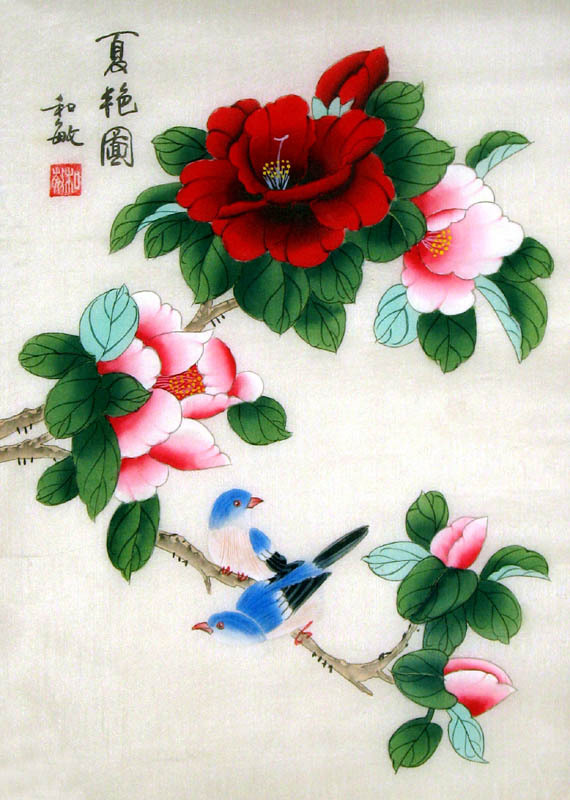 |
| Chinese Peony |
Peonies in Europe
In Europe, peonies were thought to be tokens that could protect the bearer from curses and demonic possession. Washington State University reports that peonies were placed in walkways leading to the entry doors of homes.
2013年7月5日星期五
How to Paint Peonies
Peonies are large, vibrantly colored, bushy flowers that bloom in the mid to late summer. Peonies are indigenous to the western half of North America, Asia and parts of Europe. One peony blossom will often have a multitude of petals, all of which appear to be in disarray. These blossoms have a yellow center, but the blossoms are often so packed with petals that the center is not visible.
Dip your medium-sized flat or filbert paintbrush in a medium-green paint. Apply the paintbrush to the canvas and paint a medium-thin line that expands at the end and becomes bulbous in shape. This is the stem of the peony--the bulbous end is the area where the stem attaches to the peony.
Dip another medium-sized flat or filbert paintbrush into the paint you have chosen for your peony blossom. Remember peony blossoms may be red, magenta, light pink, white or yellow.
Apply the paintbrush to the end of the stem where it attaches to the blossom. Paint a long line moving outward to the right along the bottom edge of the blossom. Eventually the line will curve upward slightly, at the edge of the blossom. This is the bottom petal on the right side.
Repeat step 3, painting a second long line, this time following the left edge of the peony blossom. The line will curve upward at the edge of the blossom. This is the bottom petal on the left side.
Dip your paintbrush in the color of the peony again. Apply the paintbrush to the middle inside of the blossom and paint a second layer of petals (one on the far right, and one on the far left), repeating the same actions you performed in steps 3 and 4. The edges of these two petals will not come quite to the edge of the bottom two petals you painted, so that the blossom will get progressively more narrow. Paint a few shorter petals sticking upward in the middle of these two petals you have just painted.
Repeat step 5 over and over, each time painting a new layer of petals above the old layer, so that the peony blossom grows upward and inward, getting increasingly more narrow as it goes. As you create new layers, mix small amounts of white with the color you are using for the petals, so that the top petals appear to be catching the light.
Dip your medium-sized flat or filbert paintbrush in a medium-green paint. Apply the paintbrush to the canvas and paint a medium-thin line that expands at the end and becomes bulbous in shape. This is the stem of the peony--the bulbous end is the area where the stem attaches to the peony.
Dip another medium-sized flat or filbert paintbrush into the paint you have chosen for your peony blossom. Remember peony blossoms may be red, magenta, light pink, white or yellow.
Apply the paintbrush to the end of the stem where it attaches to the blossom. Paint a long line moving outward to the right along the bottom edge of the blossom. Eventually the line will curve upward slightly, at the edge of the blossom. This is the bottom petal on the right side.
Repeat step 3, painting a second long line, this time following the left edge of the peony blossom. The line will curve upward at the edge of the blossom. This is the bottom petal on the left side.
Dip your paintbrush in the color of the peony again. Apply the paintbrush to the middle inside of the blossom and paint a second layer of petals (one on the far right, and one on the far left), repeating the same actions you performed in steps 3 and 4. The edges of these two petals will not come quite to the edge of the bottom two petals you painted, so that the blossom will get progressively more narrow. Paint a few shorter petals sticking upward in the middle of these two petals you have just painted.
Repeat step 5 over and over, each time painting a new layer of petals above the old layer, so that the peony blossom grows upward and inward, getting increasingly more narrow as it goes. As you create new layers, mix small amounts of white with the color you are using for the petals, so that the top petals appear to be catching the light.
Japanese Peony Flower's Meaning
The Japanese peony, considered the "King of Flowers," has a symbolic meaning that includes wealth, good fortune, honor, daring and masculine bravery. The peony originated in China; around the eighth century, the Chinese introduced the peony to Japan. The peony is a favorite flower in gardens all over the world; its symbolic meaning serves as an inspiration for a variety of art forms.
Peony Types
Peonies come in two types: tree peonies and herbaceous peonies. Tree peonies grow to about eye level, possess woody stems and a small number of branches. The stems stay alive throughout the winter and then bloom in early spring. The flower colors range from yellow, black and purple to shades of red, pink and white. Herbaceous peonies grow from 2 to 4 feet tall. They have bushy green, pink or red stems that turn green in the fall. Flower colors include pink and red varieties as well as white, yellow and cream.
Flower Types
Peony flowers are divided into five categories, according to the form of the petals, for further identification purposes. The five main types are described as single, Japanese, anemone, semi-double, double and the secondary bomb type.
Japanese Peony Flower
The Japanese peony is a transition-type between the singles and doubles. Japanese peonies have five or more guard petals surrounding the flower center; the stamens have been partially transformed into short, narrow petals called staminodes. The broadened center filaments and large anthers give the Japanese peony flower a feathery appearance. The colors of the guard petals and the center vary and come in many striking combinations.
Peony in Japanese Art
The beauty and meaning of the peony has served as inspiration for artists in both Eastern and Western cultures. When the peonies were first introduced in the eighth century, Japanese craftspeople and artists quickly began depicting the peony in their tapestries, paintings and porcelains.
Peony in Body Art
Peonies are a common tattoo subject in both Japanese and Western cultures. Its inherent meaning of prosperity and strength makes it a popular image to incorporate into body art. The peony is traditionally understood, in Japanese culture, as a "masculine" motif, embodying bravery and daring; however, both men and women use the image.
Peony in Japanese Poetry
The peony is also a popular subject of many Japanese poems, frequently appearing in Japanese haiku poetry. The peony's beauty and symbolism serve as inspiration. A Japanese poet named Issa (d. 1823), said to have written 20,000 haiku, dedicated at least 84 poems to the peony. One of Issa's peony poems reads:
The peony is this big!
the child's arms
outstretched
Another haiku refers to the peony's reputation for bringing prosperity:
The god of fortune
and luck dwells here
a peony
Poet Yosa Buson (1716 to 1783) wrote:
On all sides
the peony wards off
rain clouds
Of Buson's 3000 haiku, 28 were about the peony.
Peony Types
Peonies come in two types: tree peonies and herbaceous peonies. Tree peonies grow to about eye level, possess woody stems and a small number of branches. The stems stay alive throughout the winter and then bloom in early spring. The flower colors range from yellow, black and purple to shades of red, pink and white. Herbaceous peonies grow from 2 to 4 feet tall. They have bushy green, pink or red stems that turn green in the fall. Flower colors include pink and red varieties as well as white, yellow and cream.
Flower Types
Peony flowers are divided into five categories, according to the form of the petals, for further identification purposes. The five main types are described as single, Japanese, anemone, semi-double, double and the secondary bomb type.
Japanese Peony Flower
The Japanese peony is a transition-type between the singles and doubles. Japanese peonies have five or more guard petals surrounding the flower center; the stamens have been partially transformed into short, narrow petals called staminodes. The broadened center filaments and large anthers give the Japanese peony flower a feathery appearance. The colors of the guard petals and the center vary and come in many striking combinations.
Peony in Japanese Art
The beauty and meaning of the peony has served as inspiration for artists in both Eastern and Western cultures. When the peonies were first introduced in the eighth century, Japanese craftspeople and artists quickly began depicting the peony in their tapestries, paintings and porcelains.
Peony in Body Art
Peonies are a common tattoo subject in both Japanese and Western cultures. Its inherent meaning of prosperity and strength makes it a popular image to incorporate into body art. The peony is traditionally understood, in Japanese culture, as a "masculine" motif, embodying bravery and daring; however, both men and women use the image.
Peony in Japanese Poetry
The peony is also a popular subject of many Japanese poems, frequently appearing in Japanese haiku poetry. The peony's beauty and symbolism serve as inspiration. A Japanese poet named Issa (d. 1823), said to have written 20,000 haiku, dedicated at least 84 poems to the peony. One of Issa's peony poems reads:
The peony is this big!
the child's arms
outstretched
Another haiku refers to the peony's reputation for bringing prosperity:
The god of fortune
and luck dwells here
a peony
Poet Yosa Buson (1716 to 1783) wrote:
On all sides
the peony wards off
rain clouds
Of Buson's 3000 haiku, 28 were about the peony.
2013年7月3日星期三
About Peonies
Peonies are known for their significantly flashy blooms and full foliage. Many gardeners choose to include these perennials in their gardens because they are relatively easy to grow, give off a fine scent and give a look of enchantment. These beautiful flowers have long been a symbol of royalty and have inspired many artists and writers through the ages. Here is a brief history and account of popular varieties and uses.
History
Peonies have a history of being cultivated for at least 1,500 years in China and 1,200 years in Japan. Two species are native to America, and the rest came from various areas, stretching from Europe to China and Japan through Siberia, the Caucasus region and India. Originally cultivated for the medicinal properties of their roots, their beauty was soon in demand for the gardens and yards of the upper class. Tree peonies were introduced to Japan from China by Buddhists. Some herbaceous peonies even grow on the lower slopes of the Himalayas. Today they are grown nearly everywhere, though their importance in China and Japan may not be rivaled anywhere else.
Significance
In China and Japan, thousands of people assemble at peony festivals, such as the Luoyang Peony Festival in China's Henan Province. The tree peony is China's national flower. They are often mentioned in poems or painted in traditional Chinese brush paintings on silk or glass, carved in woodcuts and embroidered or woven into silk robes. They symbolize friendship, good luck and feminine beauty. In China, "Hua Wang" means "the king of flowers," though there are many other names for them, with meanings such as "wealthy and honorable" or "charming and beautiful." Peonies were the favorite flower of the famous Empress Wu Zetian, who ruled from the 660s to 690s A.D.
Varieties
There are thousands of species and varieties of peonies, from single layer saucer-like flowers to double layer blooms packed with hundreds of petals. They have also won favor because of all the colors possible. They can be any shade of yellow, cream, white, orange, pink, purple, crimson, maroon and just about black. There are no known blue peonies, though there are mythical reports that the emperor of China hid a special blue variety in his private garden in the late 1800s.
Tree peonies grow shrub-like from 3 to 10 feet in height, and herbaceous peonies grow from 1 to 5 feet tall. Most prefer cool dry soil and partial sun. If kept well, they will grow and blossom for a very long time. In the garden of the Twin Pagoda Monastery at Taiyuan Shanxi Province, there are 10 plants growing that are said to be 300 years old.
Benefits
The herbaceous peony is still used today in traditional Chinese medicine. Their roots have been used to prevent blood clotting for nearly 1,900 years. The roots are to be dug in summer and peeled from bark. They are dried in the sun after soaking in boiling water, then soaked again before slicing. The bitter tasting slices are said to pacify the liver and stop pain while nourishing the blood. Some varieties, such as the Phoenix White and Phoenix Pink, are grown for their bark, which has antispasmodic, analgesic and sedative properties.
Peonies in Myth
There is an Asian myth pertaining to the peony, the peacock and the phoenix. The phoenix is a mythical guardian of the Celestial Empire and is often depicted with peonies in embroideries and paintings. Other versions include peacocks or pheasants among pine trees. It is considered good luck to have one of these paintings hanging, for the painted flowers are more enduring.
Expert Insight
Famed gardener Jane Fearnley-Whitiingstall remarks on the longevity of peonies in her book "Peonies." Many people question why one should grow a flower that is only in bloom for a week or two, but she says, "Some peonies do flower for four weeks and longer, and by choosing carefully and planning for a succession of bloom you can have peonies in flower from mid April until the end of July. My own answer is that it is precisely because their season is so short that we love peonies so much."
 |
| Chinese Peony Painting |
History
Peonies have a history of being cultivated for at least 1,500 years in China and 1,200 years in Japan. Two species are native to America, and the rest came from various areas, stretching from Europe to China and Japan through Siberia, the Caucasus region and India. Originally cultivated for the medicinal properties of their roots, their beauty was soon in demand for the gardens and yards of the upper class. Tree peonies were introduced to Japan from China by Buddhists. Some herbaceous peonies even grow on the lower slopes of the Himalayas. Today they are grown nearly everywhere, though their importance in China and Japan may not be rivaled anywhere else.
Significance
In China and Japan, thousands of people assemble at peony festivals, such as the Luoyang Peony Festival in China's Henan Province. The tree peony is China's national flower. They are often mentioned in poems or painted in traditional Chinese brush paintings on silk or glass, carved in woodcuts and embroidered or woven into silk robes. They symbolize friendship, good luck and feminine beauty. In China, "Hua Wang" means "the king of flowers," though there are many other names for them, with meanings such as "wealthy and honorable" or "charming and beautiful." Peonies were the favorite flower of the famous Empress Wu Zetian, who ruled from the 660s to 690s A.D.
Varieties
There are thousands of species and varieties of peonies, from single layer saucer-like flowers to double layer blooms packed with hundreds of petals. They have also won favor because of all the colors possible. They can be any shade of yellow, cream, white, orange, pink, purple, crimson, maroon and just about black. There are no known blue peonies, though there are mythical reports that the emperor of China hid a special blue variety in his private garden in the late 1800s.
Tree peonies grow shrub-like from 3 to 10 feet in height, and herbaceous peonies grow from 1 to 5 feet tall. Most prefer cool dry soil and partial sun. If kept well, they will grow and blossom for a very long time. In the garden of the Twin Pagoda Monastery at Taiyuan Shanxi Province, there are 10 plants growing that are said to be 300 years old.
Benefits
The herbaceous peony is still used today in traditional Chinese medicine. Their roots have been used to prevent blood clotting for nearly 1,900 years. The roots are to be dug in summer and peeled from bark. They are dried in the sun after soaking in boiling water, then soaked again before slicing. The bitter tasting slices are said to pacify the liver and stop pain while nourishing the blood. Some varieties, such as the Phoenix White and Phoenix Pink, are grown for their bark, which has antispasmodic, analgesic and sedative properties.
Peonies in Myth
There is an Asian myth pertaining to the peony, the peacock and the phoenix. The phoenix is a mythical guardian of the Celestial Empire and is often depicted with peonies in embroideries and paintings. Other versions include peacocks or pheasants among pine trees. It is considered good luck to have one of these paintings hanging, for the painted flowers are more enduring.
Expert Insight
Famed gardener Jane Fearnley-Whitiingstall remarks on the longevity of peonies in her book "Peonies." Many people question why one should grow a flower that is only in bloom for a week or two, but she says, "Some peonies do flower for four weeks and longer, and by choosing carefully and planning for a succession of bloom you can have peonies in flower from mid April until the end of July. My own answer is that it is precisely because their season is so short that we love peonies so much."
The Meaning of the Peony Flower
The peony is a vibrant, fragrant and hardy flower with a long and storied history. The peony plant is linked with ancient Greek mythology and possesses other meaningful associations. It is cherished by many for its beauty, fragrance, tolerance and longevity. Today, the peony is a popular inclusion in gardens worldwide.
History
The peony is native to Asia, North America and southern Europe. Peonies were cultivated in China over 2,000 years ago. According to the Flower Expert, "Roman legions first brought peonies to England in about the year 1200." The Flower Expert also states that, "peonies were described in botanical books as early as 1636." This lovely flower has now been grown in private gardens for more than 600 years.
Medicinal Uses
The peony has been valued not only for its aesthetic properties but also for its medicinal uses. The origin of the name peony is attributed to the physician to the gods, Paeon, and according to The Flower Expert "ebisugusuri" that is the Japanese name for peony translates to "medicine from China." Chinese people have used the plant's root for food and to treat asthma symptoms, menstrual cramps and convulsions.
Types
Two types of peony plant are available; both are perennial. Both types can live for up to 50 years. The shorter, more herbaceous type commonly found in household gardens grows 2 to 4 feet tall, has fleshy stems with many leaves, and is grown from a bulb or tuber. The tree peony resembles a tall shrub, has woody stems with branches, grows 5 to 7 feet tall, and is grown from seed or grafts.
Peony flowers come in red, pink, white, orange and yellow. Seven types of peony flower grow, from giant double flowers that can reach 8 inches across to single flowers, appealing in their simplicity. Anemone, fern leaf, semi-double and Japanese are other types of peony flowers.
Meanings
The peony carries a traditional meaning of romance and prosperity, symbolizing happy marriages and good fortune. One ancient myth tells the story of Greek god Apollo's mother giving a peony to the mortal Paeon, the gods' physician, on Mount Olympus.
The peony can also symbolize compassion, based on another legend that claims Paeon was turned into a peony to spare him from a natural mortal death. China, Mongolia and the state of Indiana in the United States all claim the peony as their official flower.
Occasions
Peony is the flower associated with the 12th marriage anniversary, making it a popular gift for celebrating this occasion. It is also often seen at weddings because of its association with romance and happy marriages. Peonies are a good choice for many other occasions because of their long lasting flowers and sweet scent.
History
The peony is native to Asia, North America and southern Europe. Peonies were cultivated in China over 2,000 years ago. According to the Flower Expert, "Roman legions first brought peonies to England in about the year 1200." The Flower Expert also states that, "peonies were described in botanical books as early as 1636." This lovely flower has now been grown in private gardens for more than 600 years.
Medicinal Uses
The peony has been valued not only for its aesthetic properties but also for its medicinal uses. The origin of the name peony is attributed to the physician to the gods, Paeon, and according to The Flower Expert "ebisugusuri" that is the Japanese name for peony translates to "medicine from China." Chinese people have used the plant's root for food and to treat asthma symptoms, menstrual cramps and convulsions.
Types
Two types of peony plant are available; both are perennial. Both types can live for up to 50 years. The shorter, more herbaceous type commonly found in household gardens grows 2 to 4 feet tall, has fleshy stems with many leaves, and is grown from a bulb or tuber. The tree peony resembles a tall shrub, has woody stems with branches, grows 5 to 7 feet tall, and is grown from seed or grafts.
Peony flowers come in red, pink, white, orange and yellow. Seven types of peony flower grow, from giant double flowers that can reach 8 inches across to single flowers, appealing in their simplicity. Anemone, fern leaf, semi-double and Japanese are other types of peony flowers.
Meanings
The peony carries a traditional meaning of romance and prosperity, symbolizing happy marriages and good fortune. One ancient myth tells the story of Greek god Apollo's mother giving a peony to the mortal Paeon, the gods' physician, on Mount Olympus.
The peony can also symbolize compassion, based on another legend that claims Paeon was turned into a peony to spare him from a natural mortal death. China, Mongolia and the state of Indiana in the United States all claim the peony as their official flower.
Occasions
Peony is the flower associated with the 12th marriage anniversary, making it a popular gift for celebrating this occasion. It is also often seen at weddings because of its association with romance and happy marriages. Peonies are a good choice for many other occasions because of their long lasting flowers and sweet scent.
How to Paint Peony Flowers
Squeeze a dime-sized amount of red or dark pink water color paint on your palette. Dip a soft, tapered paint brush into some water and mix the water from the brush with a tiny amount of the paint on the palette. Mix the water and paint from the edge of the red or pink to create a light pink color.
Dip your brush into water to remove the paint. Lightly dab the sides of the brush bristles on a paper towel to remove excess water, but not all. Keep your brush somewhat wet. Load the light pink paint you made onto the brush, concentrating it on the tip.
Touch the tip of the brush to a piece of water color paper, right where you want the center of the first peony flower to appear. Apply a small amount of pressure as you roll the bristles of the brush at a slight angle until you have created a tear-drop shape with the tapered end pointing down. Make three to four of these petals touching each other to create the base of the flower. Darken the tapered tip of each petal to mimic the look of real peony petals.
Dab the brush on its side, with the tapered end of the teardrop-shaped petals all pointing to one side and create an arc from one end of the base petals to the other. Build the flower up by adding smaller petals in the same way. Leave small gaps between each new arc of petals. Add them to the top and gradually make them thinner as you go further from the base. Add more paint to the brush the same way you did in Step 2.
Touch the tip of the brush against the top edge of the base petals and create a small series of inner petals. These inner petals are darker than the outside and have a rounded tip, so you only need to use the very tip of the paint brush and create a lump extending from the top. Leave a small amount of white space between the inner petals. Keep working inward, around the arc of outer petals and press slightly harder with the brush to make them darker.
Add more of the red or dark pink paint to the brush and fill in the white gaps to create shadows between the outer petals. Press slightly harder so the brush releases more paint onto the paper. Roll the brush at an angle so it fills the white spaces. Dip your brush in green paint and add a stem to your peony flower.
Dip your brush into water to remove the paint. Lightly dab the sides of the brush bristles on a paper towel to remove excess water, but not all. Keep your brush somewhat wet. Load the light pink paint you made onto the brush, concentrating it on the tip.
Touch the tip of the brush to a piece of water color paper, right where you want the center of the first peony flower to appear. Apply a small amount of pressure as you roll the bristles of the brush at a slight angle until you have created a tear-drop shape with the tapered end pointing down. Make three to four of these petals touching each other to create the base of the flower. Darken the tapered tip of each petal to mimic the look of real peony petals.
Dab the brush on its side, with the tapered end of the teardrop-shaped petals all pointing to one side and create an arc from one end of the base petals to the other. Build the flower up by adding smaller petals in the same way. Leave small gaps between each new arc of petals. Add them to the top and gradually make them thinner as you go further from the base. Add more paint to the brush the same way you did in Step 2.
Touch the tip of the brush against the top edge of the base petals and create a small series of inner petals. These inner petals are darker than the outside and have a rounded tip, so you only need to use the very tip of the paint brush and create a lump extending from the top. Leave a small amount of white space between the inner petals. Keep working inward, around the arc of outer petals and press slightly harder with the brush to make them darker.
 | |||
| Chinese Peony Painting |
Add more of the red or dark pink paint to the brush and fill in the white gaps to create shadows between the outer petals. Press slightly harder so the brush releases more paint onto the paper. Roll the brush at an angle so it fills the white spaces. Dip your brush in green paint and add a stem to your peony flower.
订阅:
博文 (Atom)


